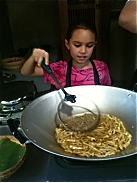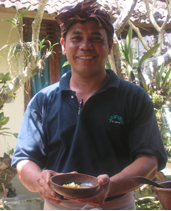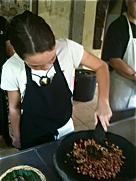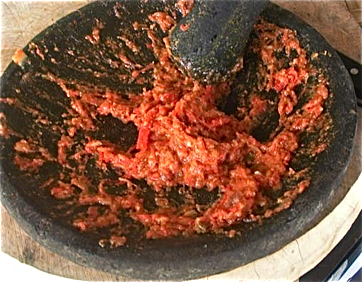Balinese Family Cooking Class Provides Wonderful Tomato Sambal Recipe
It’s always a good idea to introduce children to new cultures and to have them feel comfortable in the kitchen at an early age. So whenever we travel to a new country with our daughters, we make it a point to sign up for a local cooking class.
Recently, we attended a very special hands-on class at Lobong in Ubud. An historically artsy and holistic town in the center of Bali, Ubud is a Southeast Asian tourist haven surrounded by rice fields and beautiful Hindu temples with endless art galleries, shopping and a handful of great food finds.
Lobong is a Balinese family compound that dates back 4 generations, nearly invisible off a main road in Ubud. Today there are 18 family members living at Lobong, with the majority having more than 13 years experience in Bali’s prosperous hospitality industry. Just more than a year, Lobong is a family business and Chef Dewa Jana and his brother in law, Sang Made, have opened their home to the public as a cooking school, teaching authentic Balinese cooking. With his experience as a chef at the famed Amandari resort across the way, Chef Jana brings a wealth of knowledge to his guests and introduces the wonderful aromatics, herbs and spices used to create a Balinese feast.
We toured the sustainable property of Lobong with Sang, starting from their small animal farm and traditional family temple and ending up in their open air kitchen where we spent the afternoon prepping for our festive dinner. Our menu consisted of Chef Jana’s recipes of the Balinese classics: Tempe Manis – fried fermented soybean cake caramelized in palm sugar; Ayam Bakar – grilled chicken with aromatics and coconut milk; Pork Sate with hand ground peanut sauce; and two types of sambal.
One of the key elements of Balinese cooking is the sambal (or spice paste) made in a dish-shaped stone mortar and curved pestle. The aromatic pastes of fresh chilis, turmeric, galangal, garlic and shallots are used as the base for most dishes and condiments. When this paste is fried in coconut oil (which Lobong makes homemade), it has an amazing aroma and, according, to Chef Jana, is essential to the seasoning of the sambal. In general, the sambals and food of Bali are known for their spiciness, tending to be less sweet than other regions of Indonesia.
Before sitting down to our dinner, we followed Sang’s elegant mother to the family temple to make the evening offering to the Gods to give thanks for our wonderful meal. Lobong is an incredibly elegant, rustic property. What makes it so special is Dewa Jana and Sang Made’s desire to share the importance of their family, culture and customs through teaching thoughtfully prepared food. Below is the recipe they shared with us for their lovely Tomato Sambal.
Tomato Sambal
Ingredients:
8 small or 4 large shallots, peeled and chopped
5 cloves garlic, peeled and chopped
8 large red chilis, seeded and chopped
2 small tomatoes, seeded and chopped
1 teaspoon shrimp paste
1 tablespoon lime juice
1/2 teaspoon salt
2 tablespoons coconut oil or canola oil
Directions:
In a mortar and pestle, grind together the shallots, garlic and chilis to form a smooth paste. In a medium saute pan over medium-high heat, add the coconut oil and saute the paste while continuously stirring. Once the paste turns a shade darker, about 5 to 7 minutes, stir in the tomatoes and shrimp paste and simmer for another 10 minutes over low heat.
Remove the pan from the heat and stir in the lime juice into the sambal. Season to taste with salt. Serve at room temperature. Keeps refrigerated up to 1 week.










